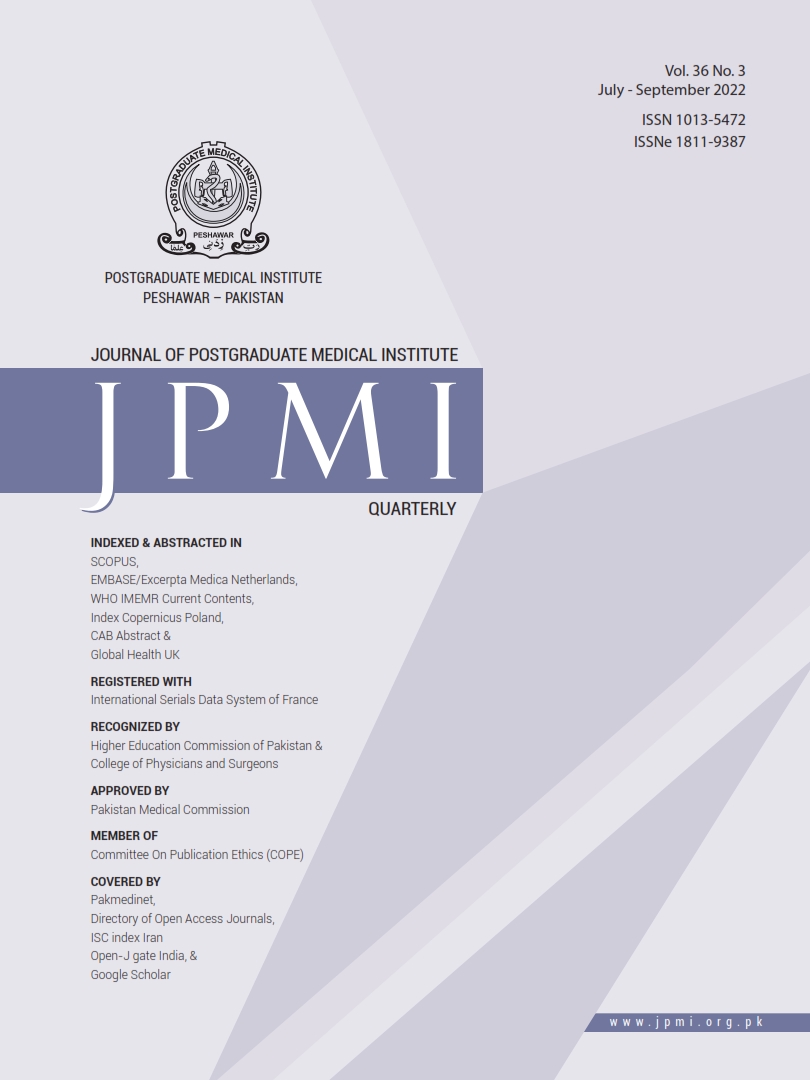THROMBOCYTOPENIA AMONG NEONATES HAVING CULTUREPROVEN SEPSIS AT A TERTIARY CARE HOSPITAL IN PAKISTAN
Main Article Content
Abstract
Objectives: To determine the frequency of thrombocytopenia in culture-positive neonatal sepsis.
Methodology: This hospital-based cross-sectional study was conducted at a tertiary care hospital of Pakistan between July to December 2021 at the Department of Pediatrics, National Institue of Child Health Karachi - Pakistan. All the neonates admitted to NICU with signs and symptoms of sepsis and positive blood culture were enrolled for this study. Complete blood count, C - reactive protein (CRP) and blood culture were sent. All the data regarding age, gender, birth weight, platelet count, and the organism isolated on blood culture was recorded in a proforma. Data was analyzed statistically and p=0.05 was considered to be statistically significant.
Results: Two hundred forty-six babies were included in the study. The mean gestational age was 37±0.56 weeks and birth weight was 3.4±0.67 kg. Male to female ratio was 1.2:1 and the mean age of admission was 6.37+5.99 days. Thrombocytopenia was found in 192 (78.4%) of neonates. There was a significant association of Burkrolderia cepacia (p=0.002), Klebsiella pneumonia (p=0.032), and Serratia marcescens (p=0.027) with thrombocytopenia.
Conclusions: Thrombocytopenia is strongly associated with gram-negative bacteria and the most prevalent organism found in thrombocytopenic neonates was Burkrolderia cepacia.
Article Details
Work published in JPMI is licensed under a
Creative Commons Attribution-NonCommercial 2.0 Generic License.
Authors are permitted and encouraged to post their work online (e.g., in institutional repositories or on their website) prior to and during the submission process, as it can lead to productive exchanges, as well as earlier and greater citation of published work.
References
Rahman Mitul A. Surgical Neonatal Sep¬sis in Developing Countries. J Neonatal Surg. 2015;4(4):41-4.
Ahirrao BM, David N, Ahirrao M, Gadre AS, Gondane S. Diagnostic utility of He¬matological Scoring System (HSS) with clinico-pathological and bacteriological evaluation in early diagnosis of neo¬natal sepsis. Annals Pathol Lab Med. 2017;4(6):721-6.
Guo J, Luo Y, Wu Y, Lai W, Mu X. Clini¬cal Characteristic and Pathogen Spec¬trum of Neonatal Sepsis in Guangzhou City from June 2011 to June 2017. Med Sci Monit. 2019;25:2296-2304. DOI:10.12659/MSM.912375..
Ahmad S, Hussain N, Rafique T, Saleem R. Frequency of thrombocytopenia and its association with mortality among neonates having probable or culture proven sepsis. Professional Med J. 2020;27(12):2739-43. DOI:10.29309/ tpmj/2020.27.12.4520
Amare D, Mela M, Dessie G. Unfinished agenda of the neonates in developing countries: magnitude of neonatal sep¬sis: systematic review and meta-anal¬ysis. Heliyon. 2019;5(9):e02519. DOI:10.1016/j.heliyon.2019.e02519.
Utomo MT, Sumitro KR, Etika R, Widodo ADW. Current-proven neonatal sepsis in Indonesian tertiary neonatal inten¬sive care unit: a hematological and microbiological profile. Iran J Microbiol. 2021;13(3):266-273. DOI:10.18502/ ijm.v13i3.6386.
Gupta B, Gupta B, Shrivastava A, Chetri P. A study of neonatal sepsis and its re¬lation to thrombocytopenia in neonates of tertiary care hospital of Western Ne¬pal. J Preg Child Health. 2019;6(421):2.
Bhowmik A, Samanta M, Hazra A, Goswami A, Ray S, Sabui TK. Study to evaluate the role of TNFa, IL1ß, IL6 in diagnosis and severity assessment of neonatal sepsis among term, appropri¬ate for gestational age newborns. Peri¬natal J. 2021;29(3):179-85.
Ahmed M, Yasrab M, Khushdil A, Qamar K, Ahmed Z. Neonatal sepsis in a tertia¬ry care hospital: bacteriological profile and its antibicrobial sensitivity. PAFMJ. 2018;68(6):1654-8.
Ree IMC, Fustolo Gunnink SF, Bek¬ker V, Fijnvandraat KJ, Steggerda SJ, Lopriore E. Thrombocytopenia in neonatal sepsis: Incidence, severity and risk factors. PLoS One. 2017 Oct 4;12(10):e0185581. DOI:10.1371/ journal.pone.0185581.
Addil F, Rehman A, Najeeb S, Imtiaz H, Khan S. Neonatal Sepsis: The Fre¬quency of Thrombocytopenia. Sys Rev Pharm. 2021;12(11):3460-2.
Bhat Y R, Kousika P, Lewis L, Pur¬kayastha J. Prevalence and severity of thrombocytopenia in blood culture prov¬en neonatal sepsis: a prospective study. Arch Pediatr Infect Dis. 2018;6(2).
Sindhura Y, Reddy K. A study of neo¬natal thrombocytopenia in Neona¬tal Sepsis. Int J Contemp Med Res. 2017;4(11):2250-2.
Kausar M, Salahuddin I, Naveed A. Examine the Frequency of Thrombo¬cytopenia in Newborns with Neonatal Sepsis. Pakistan J Medical Health Sci. 2020;14(2):657-9.
Arif SH, Ahmad I, Ali SM, Khan HM. Thrombocytopenia and bacterial sep¬sis in neonates. Indian J Hematol Blood Transfus. 2012;28(3):147-51. DOI:10.1007/s12288-011-0118-7.
Patel SM, Patel K, Patel K, Thaddanee R. Comparison of outcomes of throm¬bocytopenic and non-thrombocytope¬nic culture proven neonatal sepsis. Int J Contemp Pediatr. 2021;8(3):512. D O I : 1 0 . 1 8 2 0 3 / 2 3 4 9 - 3 2 9 1 . ijcp20210656
Manzoni P. Hematologic Aspects of Ear¬ly and Late-Onset Sepsis in Preterm Infants. Clin Perinatol. 2015;42(3):587- 95. DOI:10.1016/j.clp.2015.04.012.
Zea Vera A, Ochoa TJ. Challenges in the diagnosis and management of neonatal sepsis. J Trop Pediatr. 2015;61(1):1- 13. DOI:10.1093/tropej/fmu079.
Rizwan W, Azhar A S, MQ K, A Waheed Q. Indicators of early outcome in Neona¬tal Sepsis.Biomedica.2005;21:117-20.
Ogundare E, Akintayo A, Aladekomo T, Adeyemi L, Ogunlesi T, Oyelami O. Presentation and outcomes of ear¬ly and late onset neonatal sepsis in a Nigerian Hospital. Afr Health Sci. 2019;19(3):2390-2399. DOI:10.4314/ ahs.v19i3.12.
Javaid S, Waheed K, Sheikh M, Gul R, Nizami N, Fatima ST. Is Thrombocytope¬nia Consistent with Specific Bacterial/ Fungal Neonatal Sepsis. Infec Dis J Pak. 2016;25(2):27-30.
Mohamed AF, Alaskar SA, Alkhamis RI, Fatmah O, Karar T. The association be¬tween neonatal sepsis and C-reactive protein: a cross-sectional study at ter¬tiary care hospital. Int J Med Health res. 2019;8(4):54-60.
Bunduki GK, Adu-Sarkodie Y. The use¬fulness of C-reactive protein as a bio¬marker in predicting neonatal sepsis in a sub-Saharan African region. BMC Res Notes. 2020;13(1):194. DOI:10.1186/ s13104-020-05033-1.


